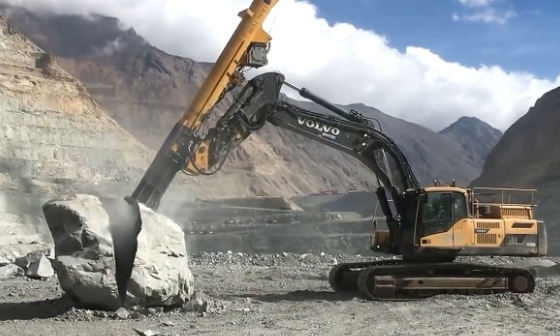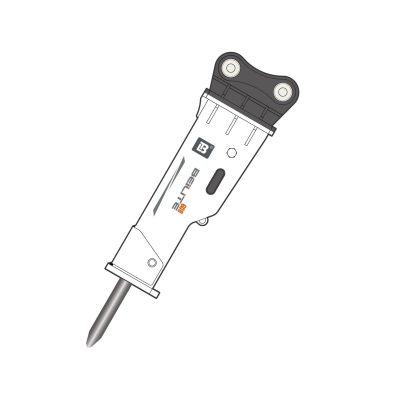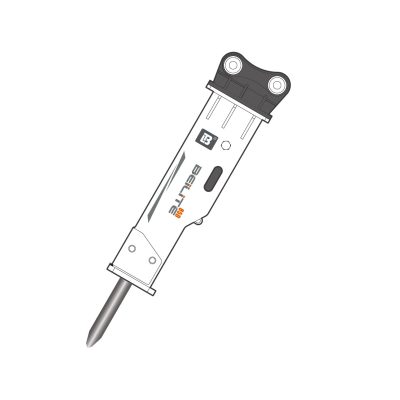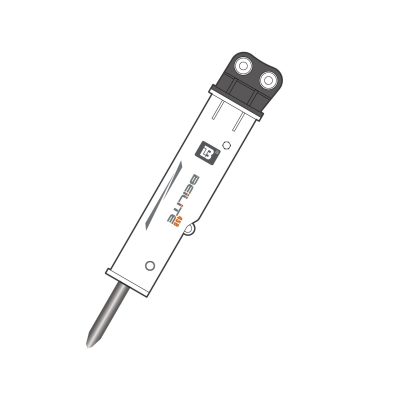鉱業はパワーと精度を要求する
採掘作業では、過酷な環境に耐え、安定した結果をもたらすツールが求められます。作業員はコンパクトな岩層、摩耗しやすい地形、厳しいスケジュールに直面します。このような状況において、チームは、効率的に岩を砕き、掘削機にフィットし、ダウンタイムを削減する機器を必要とします。A 油圧ブレーカーハンマー そのニーズに応えるために必要な強さとコントロールを提供する。

を理解する 油圧ブレーカーハンマー
A 油圧ブレーカーハンマー 掘削機や運搬船からの油圧を利用して、岩やコンクリートのような硬い材料にチゼルを打ち込みます。このツールは、採鉱や採石において重要な役割を果たし、作業者が残土を除去したり、大きな岩を砕いたり、岩の表面を整えたりするのに役立ちます。鉱山では、発破や手作業を減らすためにこれらのハンマーを頼りにしています。
オペレーターは 掘削機用ブレーカーハンマー のブームまたはアームに直接接続します。機械はそれからハンマーを通って油圧エネルギーを指示し、機械力に流動力を変える。この力が岩を砕き、材料を素早く分離します。スピードと精度を必要とするチームは、このアプローチに信頼を寄せている。
鉱山が他の方法よりも油圧ブレーカーを選ぶ理由
多くの鉱山が火薬の使用を減らしているのは、より安 全で制御性の高いツールを好んでいるからである。爆薬は許可を必要とし、振動を発生させ、しばしば近隣の地層を損傷する。A 採掘用ロックブレーカー は、より集中的なソリューションを提供します。オペレーターは出力を制御し、表面に直接エネルギーを加え、ブラストからの破片の除去に起因する遅延を排除します。
に切り替えると、ダウンタイムが短縮される。 砕岩機 油圧ブレーカーのようなチームは燃料を節約し、機械を保護し、生産性を向上させます。これらのハンマーは、きれいなブレークを提供し、二次処理の必要性を最小限に抑えます。
企業力を支えるコア・コンポーネント 油圧ブレーカーハンマー
それぞれ 採石用油圧ハンマー には、いくつかの重要なコンポーネントが含まれており、それらが連動している:
- シリンダー:ピストンを動かしてハンマリングアクションを生み出す。
- ピストン:チゼルにエネルギーを伝える。
- バルブシステム:オイルフローとハンマリング速度を制御。
- チゼル工具:岩に直接接触し、割れ目を形成する。
- アキュムレーター:圧力を貯蔵し、圧力のピークを低減します。
- 取り付けブラケット:ハンマーを掘削機に接続します。
耐久性のある素材と精密に設計された部品を使用することで、メーカーは各ブレーカーが日々の採掘作業のストレスに耐えることを保証しています。
適切なブレーカとショベルの組み合わせ
ベスト 掘削機用ブレーカーハンマー は、キャリアの重量クラス、流量、および使用目的に適合します。サイズの小さいハンマーは性能が劣ります。オーバーサイズのモデルは、機器にストレスを与え、燃料を過剰に消費します。オペレータは、花崗岩、石灰岩、または他の材料を扱うかどうかにかかわらず、特定の採鉱アプリケーションに適合するモデルを選択する必要があります。
キャリアの互換性により、よりスムーズな運用が可能になります。また、正しいモデルを設置するチームは、メンテナンスの必要性を減らし、機器の寿命を延ばします。
オペレーターの使い方 油圧ブレーカーハンマー 鉱業
オペレーターはチゼル工具を岩石表面に対して90度の角度で配置する。コントロールキャビンから油圧を作動させ、ブレーカに繰り返し力を加える。熟練したオペレーターは、滑ったり跳ねたりすることを避け、チゼルと掘削機の両方を保護します。
採掘チームはしばしば 採石用ロックハンマー 破砕機に入らないような大きな岩を砕くため。また、溝を作ったり、継ぎ目を露出させたり、平らな表面を整えたりするために使用することもあります。これらの用途では、困難な環境でも正確な制御が可能です。
油圧ブレーカーの一般的な採鉱用途
鉱山使用 鉱業用油圧解体工具 様々な仕事において:
- オーバーバーデンの除去
- 玉石の二次破砕
- トンネル掘削
- 斜面の安定化
- 排水用トレンチ
- 鉱山道路建設
これらの工具は、制御された力と定期的な破壊サイクルを必要とする現場で最もよく機能する。ドリルや手動工具とは異なり、油圧ハンマーはスピードと均一性を提供します。
ビーライトの油圧ブレーカで鉱山の生産性を高める
ベイライトは以下を提供する。 ヘビーデューティー油圧ブレーカー 大規模作業に適したモデル。エンジニアは、厳しい岩石タイプや長時間の作業にも耐えられるよう、これらのツールを設計している。各ユニットは、高強度材料、振動低減技術、効率的なオイルチャネルを使用しています。
Beiliteのブレーカーを使用するチームは、仕事を早く終え、修理に費やす時間を短縮できます。この設計は、背圧や衝撃からキャリアマシンを保護するのに役立ちます。また、Beiliteはサポートを提供するため、摩耗部品の交換が容易で、機器の稼働を維持することができます。
安全性とメンテナンスが高い生産性を維持
オペレーターは、ガイドラインに従って安全な作業環境を維持する。工具を毎日点検し、ボルトが締まっていることを確認し、適切なオイルを使用する。技術者は、亀裂が入る前に摩耗したノミを交換する。メンテナンス・チームは、定期的な潤滑を行い、ガス圧を調整し、作動油のレベルを監視する。
Beiliteは、ユーザーマニュアルとサポートにより、ユーザーがメンテナンスルーチンに従うことを支援する。また、すべての主要モデルに適合する部品を提供しています。これらのステップにより マイニングブレーカーハンマー より長く使用でき、プレッシャーの下でも性能を発揮する。
適切な岩に適切な道具を選ぶ
すべてのノミが同じように使えるわけではありません。Beiliteは岩石の種類に合わせたツールを提供しています:
- モイルポイント:層状岩盤の一般的なブレーキング用
- 平ノミ:精密整形用
- 鈍い工具:広い面に衝撃力を与える
- ウェッジツール:硬い岩の継ぎ目を割る
適切なツールを選択することで、生産性が向上する。岩石の種類に応じて工具を切り替えるオペレーターは、作業を早く終え、機械のストレスを軽減する。
過酷な採掘環境におけるダウンタイムの最小化
鉱山の環境は、最もタフな機器でさえも挑戦します。ほこり、熱、寒さ、振動はすべて部品を摩耗させます。Beiliteは、保護シール、強化ハウジング、効率的な冷却を使用して対応します。これらの機能は油圧システムの安定性を保ち、オイル漏れを防ぎます。
に頼るクルー 鉱業用油圧ブレーカー また、モジュラー・コンポーネントの利点もあります。クイックアクセス設計により、メカニックは長い時間をかけずに部品を交換することができます。Beiliteはトレーニングや技術的なアドバイスでこれらのチームをサポートします。
Beilite油圧ブレーカが厳しい鉱山に適合する理由
Beiliteは採掘条件を念頭に置いて工具を設計しています。それぞれ 油圧ブレーカーハンマー 業界標準を満たし、長い耐用年数を提供します。エンジニアは納品前にすべての部品をテストします。設計は振動を減らし、摩耗から掘削機を保護します。
Beiliteブレーカを使用している鉱山では、プロジェクトのスケジュールが短縮され、燃料の使用量が減り、修理の回数が減りました。このブランドは、小型、中型、および大型の掘削機用のフルレンジのモデルを提供しています。Beiliteに投資するチームは、効率とサポートの両方を得ることができます。
最終的な感想マイニングの進歩を推進するブレーカー
採掘作業は、適切なツールに頼ることで成功する。A 油圧ブレーカーハンマー は、岩を砕き、キャリアを保護し、生産を軌道に乗せるために必要な力を提供します。Beiliteは、強度と精度を追求した装置で、鉱山労働者が目標を達成できるよう支援します。
よくある質問
サイズ 油圧ブレーカーハンマー 私のショベルカーに合いますか?
ショベルの重量、油圧流量、および圧力範囲に合ったブレーカを選択する必要があります。Beiliteは、6トンから45トンまでのマシンに対応するモデルを提供しています。
メンテナンスの頻度 採石用油圧ハンマー?
ハンマーは毎日点検し、250~500時間の使用ごとにフルサービスを行う必要があります。常に取扱説明書に従い、推奨オイルと部品を使用してください。
を使用することはできますか? 採掘用ロックブレーカー ウェットコンディションで?
Beilite油圧ブレーカには、保護シールと強化ケーシングが付属しています。作業者はハンマーを水没させないようにし、ぬかるんだ場所や濡れた場所では使用後に点検する必要があります。
モイルポイントとフラットチゼルの違いは何ですか?
モイル・ポイントは層状の岩を貫通し、一点で砕く。フラットチゼルは、より広い面に力を分散させるので、形を整えたり、狭い場所での作業に適している。









